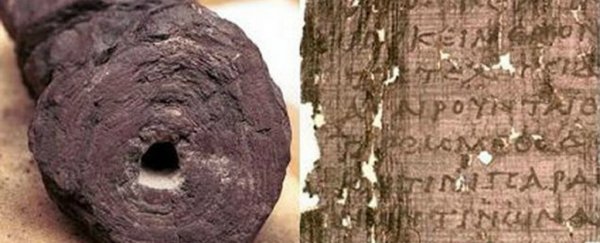About 2,000 years ago, Mount Vesuvius erupted explosively and burned down a library full of ancient scrolls. Since researchers found the texts - known as the Herculaneum scrolls - back in the 18th century, scientists around the world have been trying to read them… without much success. But it may have just got a bit easier thanks to X-ray scans from the European Radiation Synchrotron Facility.
But to step back a second, here's a brief summary of what the scrolls are and what scientists think they know about them. Back in 79 AD, Mount Vesuvius erupted and buried two towns: Pompeii, which gets most of the spotlight, and Herculaneum.
Inside a library at Herculaneum were a bunch of hand-written, fragile papyrus scrolls that researchers think most likely contain works by Philodemus and Virgil - two extremely influential teachers, philosophers, and writers. In 1752, researchers found 1,800 of these charred, rolled scrolls and have since been trying to unlock their secrets, which has proven ridiculously difficult, since a strong breeze is enough to ruin them forever.
Now, according to a report from The Guardian, researchers from the European Radiation Synchrotron Facility, who are able to produce an X-ray beam "100 billion times brighter than anything used in a hospital", were able to look inside the charred scrolls without damaging them.
When the analysis was complete, the team found that the scrolls were written with metallic ink, a medium that researchers didn't even think existed back when the scrolls were penned.
Though researchers still haven't been able to really read anything inside the scrolls, understanding how they were written will allow them to better design methods to eventually decipher the text.
However, the new findings are an even bigger deal for historians and archaeologists, because it completely changes the way they thought people wrote. Daniel Delattre, one of the study's authors, told The Guardian:
"For nearly 2,000 years, we thought we knew everything, or almost everything, about the composition of antique ink used to write on papyrus. The highly specialised studies carried out at the European synchrotron show us that we must be wary of our ideas and that the ink also contained metal, notably lead in sizeable quantities."
This new information means that researchers may be able to read other unread texts using similar X-rays, which could unlock a treasure trove of new data about the ancient world. It's a very exciting time for archaeologists and historians, to say the least.
Obviously, the real hope is to one day read the scrolls. There's no estimate of when that day might come, however, since X-ray technology and other techniques are moving along at such a decent clip, it isn't a stretch think that that may happen in our lifetimes.
You can read about the team's latest findings in Proceedings of the National Academy of Sciences.
